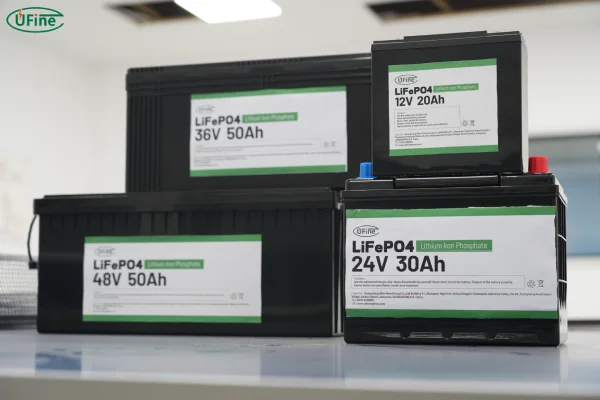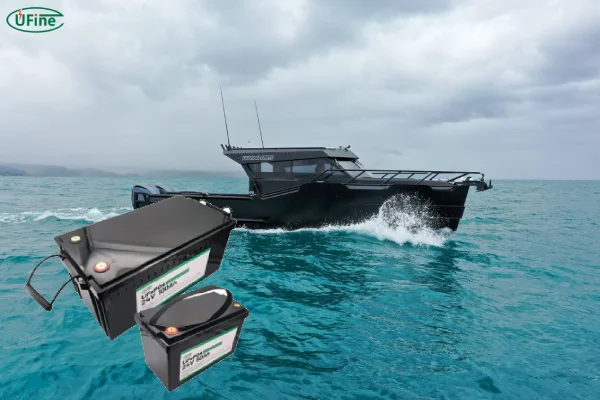
- Part 1. What is the difference between marine batteries?
- Part 2. Different types of marine batteries
- Part 3. What is a dual purpose marine battery?
- Part 4. Advantages and disadvantages of dual purpose marine battery
- Part 5. How does a dual purpose marine battery power a boat?
- Part 6. Dual purpose marine battery vs. deep-cycle marine battery
- Part 7. Buying a dual purpose marine battery: 7 key parameters
- Part 8. Dual purpose marine battery maintenance tips
If you own a boat, you know how crucial it is to have a reliable power source onboard. Whether you’re out on the water for a relaxing day or navigating through challenging conditions, your boat’s electrical system needs a constant, dependable power supply. This is where dual purpose marine batteries come in.
In this article, we’ll explore the ins and outs of dual purpose marine batteries, diving deep into what they are, how they differ from other types of marine batteries, and how you can choose the best one for your boat. We’ll also touch on the pros and cons, maintenance tips, and the key factors to consider when buying one.
Part 1. What is the difference between marine batteries?

Before we dive into the details of dual purpose marine batteries, it’s important to understand what sets marine batteries apart from regular car batteries. Unlike car batteries, which are designed to handle dry, static environments, marine batteries are built to withstand the harsh conditions that come with being on the water.
Marine batteries must contend with:
-
Corrosion from Saltwater: Boats are often exposed to salty air and seawater, both of which can quickly corrode standard batteries. Marine batteries are made with corrosion-resistant materials to avoid this problem.
-
Frequent Vibrations: Boats are constantly moving, and the vibrations from the engine and the water can cause internal damage to traditional batteries. Marine batteries are designed with vibration-resistant features to withstand this constant motion.
-
Exposure to Moisture: Humidity and splashing water are common aboard boats, so marine batteries come with durable, sealed casings that prevent water from seeping inside and damaging the battery components.
These features ensure that a marine battery can operate reliably in a marine environment. They are engineered to offer consistent power, whether you are navigating through calm or choppy waters.
Part 2. Different types of marine batteries
Marine batteries come in various types, each suited for different functions on your boat. While we won’t dive into battery chemistry in this section, it’s crucial to understand the basic categories of marine batteries:
-
Starting Batteries: These batteries are designed to provide a powerful burst of energy to start the boat’s engine. They typically deliver a high amount of cold-cranking amps (CCA), which are essential for starting the engine, especially in cold weather. However, starting batteries are not designed to provide long-lasting power to onboard systems, and frequent deep discharges can damage them.
-
Deep-Cycle Batteries: Unlike starting batteries, deep-cycle batteries are made to discharge more deeply without damaging their internal components. These batteries are ideal for powering boat electronics like radios, GPS systems, and lights. However, they lack the cranking power necessary to start the engine.
-
Dual-Purpose Batteries: These batteries are a hybrid solution, combining the features of both starting and deep-cycle batteries. A dual purpose marine battery provides enough cranking power to start your engine while also being capable of powering electronics for a prolonged period. This versatility makes them an excellent choice for boat owners who need both functions but prefer the simplicity of a single battery.
-
Trolling Motor Batteries: Specifically designed for trolling motors, these batteries are optimized for long-term, low-power usage. They offer extended discharge times but are not suitable for starting engines.
Part 3. What is a dual purpose marine battery?
A dual purpose marine battery is a versatile solution that combines the cranking power of a starting battery with the deep discharge capability of a deep-cycle battery. This hybrid battery is designed to meet the needs of boaters who need a reliable power source for both starting their engine and running essential electronics.
The key advantage of dual purpose marine batteries is their ability to handle both high-power, short-duration tasks (like starting the engine) and low-power, long-duration tasks (like running a fish finder or GPS). As a result, they are a great option for smaller boats or those who don’t want to manage multiple batteries.
Key Features:
- Cranking Power: Dual-purpose marine batteries deliver enough cold-cranking amps (CCA) to start your engine reliably.
- Deep-Cycle Capability: They can discharge deeply without damaging the battery, making them suitable for powering electronics like radios and navigation systems.
- Durability: These batteries are designed to endure the harsh marine environment, with sealed, corrosion-resistant casings and vibration-resistant features.
In short, a dual purpose marine battery is the all-in-one solution for those who need both starting and deep-cycle power on their boat.
Part 4. Advantages and disadvantages of dual purpose marine battery
Like any battery, dual purpose marine batteries come with both advantages and disadvantages. Let’s take a closer look at the pros and cons.
Advantages:
-
Versatility: The most obvious benefit is the versatility of having one battery that serves both purposes—starting the engine and powering electronics. This eliminates the need for multiple batteries, which can save space and reduce overall costs.
-
Space and Weight Savings: For many boaters, space and weight are at a premium. A dual purpose battery offers the convenience of a two-in-one solution, which means more room on your boat for other gear.
-
Cost-Effective: Buying a single dual purpose marine battery is generally more affordable than purchasing both a starting battery and a deep-cycle battery. This makes it an attractive option for boaters on a budget.
-
Simplicity: With just one battery to maintain and replace, you simplify the management of your boat’s power system.
Disadvantages:
-
Not Optimal for Long-Term Power: While a dual-purpose battery is good for moderate use, it may not provide the same performance as a dedicated deep-cycle battery when running electronics over extended periods. If you often use high-drain devices for long hours, a dedicated deep-cycle battery may be a better option.
-
Shorter Lifespan Under Heavy Use: If you’re frequently draining the battery, its lifespan may be shorter than a dedicated deep-cycle battery, which is designed for prolonged discharges.
-
Limited Cranking Power: While dual-purpose batteries can start engines, they may not deliver as much cranking power as a dedicated starting battery, especially in extreme cold conditions.
Part 5. How does a dual purpose marine battery power a boat?
Understanding how a dual-purpose marine battery powers a boat is essential for knowing how to use it most effectively. Here’s a breakdown of the process:
-
Starting the Engine: When you turn the key or press the ignition button, the battery delivers a burst of energy to the starter motor, which turns the engine over. The high cold cranking amps (CCA) provided by the battery are designed to get your engine started quickly and efficiently.
-
Powering Electronics: After the engine is running, the battery also supplies power to your boat’s electronics. This includes everything from lights and radios to GPS systems, fish finders, and more. The battery discharges gradually as these devices draw power.
-
Recharging: As the engine runs, the alternator recharges the battery, ensuring it stays at an optimal charge level. This cycle of discharging and recharging continues as long as the boat is in use.
In essence, the dual-purpose marine battery serves as both the “spark” to get your engine running and the reliable energy source to keep your boat’s electronics powered while you’re on the water.
Part 6. Dual purpose marine battery vs. deep-cycle marine battery
While dual purpose marine batteries and deep-cycle marine batteries are often compared, there are key differences between the two:
-
Dual Purpose Marine Battery: Best for boats where both starting and moderate deep-cycling functions are needed. It’s a hybrid solution designed to handle both tasks without excelling at either one.
-
Deep-Cycle Marine Battery: Specifically designed for powering electronics over long periods. It can be discharged deeply without damage, making it ideal for long-term use. However, it doesn’t have the cranking power necessary to start a boat’s engine.
In some cases, boaters opt for a combination of both batteries: a dual-purpose marine battery for starting the engine and a deep-cycle battery for powering electronics. This setup ensures optimal performance for both tasks, although it requires more space and maintenance.
Part 7. Buying a dual purpose marine battery: 7 key parameters
When purchasing a dual-purpose marine battery, there are several key factors to consider to ensure you choose the right one for your needs:
-
Cold Cranking Amps (CCA): A higher CCA means the battery can provide more power to start the engine in cold weather. Make sure the battery has enough CCA for your boat’s engine.
-
Amp-Hour Rating (Ah): This indicates the battery’s capacity to power electronics. A higher Ah means more power to run your lights, radio, and other devices.
-
Voltage: Most marine batteries are 12V, but some boats may require 24V or even 48V batteries. Be sure to select the right voltage for your boat’s electrical system.
-
Battery Type (AGM, Gel, Flooded): AGM and Gel batteries are maintenance-free and more durable,
while flooded batteries are cheaper but require more maintenance.
-
Size and Weight: Ensure the battery fits within your boat’s designated battery compartment, and keep in mind that larger batteries can be heavy.
-
Warranty: Look for a battery with a solid warranty, typically ranging from 1 to 3 years, depending on the brand and quality.
-
Brand Reputation: Choose reputable brands known for producing high-quality marine batteries, such as Optima, Trojan, or Interstate.
Part 8. Dual purpose marine battery maintenance tips
To get the most out of your dual-purpose marine battery, proper maintenance is essential. Here are a few tips:
-
Regularly Check the Charge Level: Ensure your battery is fully charged before heading out on the water to avoid running out of power.
-
Keep Terminals Clean: Corroded terminals can reduce the efficiency of your battery. Clean them regularly using a wire brush and a mixture of baking soda and water.
-
Store Properly: If your boat will be sitting idle for a while, store the battery in a cool, dry place. Avoid letting it sit in a discharged state for long periods, as this can shorten its lifespan.
-
Inspect for Leaks or Damage: Regularly check for signs of damage or leaks, which can lead to failure. If you notice any issues, address them immediately.
In conclusion, a dual-purpose marine battery is a fantastic option for boaters who want an all-in-one solution for starting their engine and powering electronics. By understanding the advantages, disadvantages, and maintenance needs of these batteries, you can make an informed decision that ensures your boat’s power system stays reliable for years to come.
Related Tags:
More Articles

Battery Load Test: A Comprehensive Guide
Step-by-step battery load test guide for car, solar & industrial use. Learn how to load test a battery, interpret voltage charts, and avoid common mistakes.
The Comprehensive Guide to Battery Balancing and Battery Balancer
Discover how battery balancers improve lithium battery performance, lifespan, and safety. Learn types, functions, and tips to choose the right balancer.
What Is the Best Voltage for a Chainsaw Battery?
Compare 12V-80V chainsaw batteries for light pruning, medium firewood, and professional cutting. See best battery chainsaw with runtime charts and safety tips.
Lithium VS. Alkaline Batteries: A Comprehensive Comparison
Lithium batteries last 3–7× longer than alkaline and perform better in cold weather. Compare lifespan, cost, safety, and best uses to choose the right battery.
Comparing Lithium-Sulfur and Lithium-Ion Batteries: Which is Right for You?
Compare lithium-sulfur (Li-S) and lithium-ion batteries on energy, lifespan, cost, safety, and applications. Best choice for drones, EVs, and electronics.



